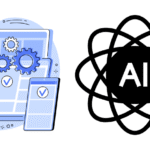How to use agile within a cross-platform development team to master the art of adaptability and deliver exceptional products? Discover the secrets here!

Imagine cross-platform development as a bustling city intersection where multiple streets converge. Each road represents a different platform, and the traffic of developers, stakeholders, and users must flow smoothly for a successful project.
In this scenario, agile methodology acts as the traffic light system that expertly guides and coordinates the flow.
Step 1: Establish a Clear Vision
Key Takeaway: Ensure everyone understands the project’s goals.
To kick things off, it’s crucial to establish a shared understanding of the project’s purpose, goals, and scope. This common vision aligns the team and paves the way for effective collaboration.
Exemplify: Consider a project to develop a fitness app for Android and iOS. The team should agree on the core features, target audience, and project timeline.
Pro tip: Use a vision statement or project charter to clarify the project’s direction.
Step 2: Assemble a Cross-Functional Team
Key Takeaway: Diverse skills lead to successful project outcomes.
Cross-platform development requires a diverse set of expertise. Assemble a team with a mix of skills, including front-end and back-end developers, UI/UX designers, and QA testers.
Exemplify: For our fitness app, the team might include Android and iOS developers, a designer with experience in both platforms, and a QA tester familiar with cross-platform testing.
Pro tip: Encourage collaboration by fostering a supportive team culture.
Step 3: Adopt an Agile Framework
Key Takeaway: Choose an agile framework that fits your team’s needs.
In a cross-platform development setting, an agile framework like Scrum or Kanban will help the team stay focused and adaptable. Select the one that aligns with your team’s work style and project requirements.
Exemplify: The fitness app team might choose Scrum for its iterative approach and regular progress updates.
Pro tip: Don’t be afraid to customize the framework to suit your team’s unique needs.
Step 4: Plan and Prioritize Work
Key Takeaway: Break the project into manageable tasks and prioritize them.
Divide the project into smaller tasks or user stories and prioritize them based on their importance and dependencies. This approach enables the team to deliver value incrementally and respond to change more effectively.
Exemplify: For the fitness app, high-priority tasks might include creating user authentication and developing core workout features.
Pro tip: Use a product backlog to keep track of tasks and priorities.
Step 5: Embrace Iterative Development
Key Takeaway: Deliver incremental value through short development cycles.
Agile development emphasizes iterative progress through short development cycles called sprints. These sprints typically last two to four weeks and result in a working piece of software.
Exemplify: In the fitness app project, the team might complete user authentication in the first sprint and develop workout features in subsequent sprints.
Pro tip: Regularly review and adjust sprint goals based on feedback and changing requirements.
Step 6: Foster Open Communication
Key Takeaway: Transparent communication is vital for project success.
Effective communication is essential in agile cross-platform development. Hold regular meetings to discuss progress, challenges, and plans, and ensure team members have access to up-to-date project information.
Exemplify: The fitness app team could hold daily stand-up meetings and use a shared task board for transparency.
Pro tip: Encourage open dialogue and active listening among team members.
Step 7: Test and Iterate
Key Takeaway: Continuous testing and improvement ensure a high-quality product.
In cross-platform development, frequent testing and iteration are vital for delivering a high-quality product. Implement continuous testing to catch issues early, and make improvements based on feedback from users and stakeholders.
Exemplify: The fitness app team could use automated testing tools and conduct regular user tests to identify areas for improvement and enhancement.
Pro tip: Encourage a mindset of continuous improvement and learning within the team.
Step 8: Reflect and Adapt
Key Takeaway: Regularly evaluate the team’s performance and adapt as needed.
Agile methodology values reflection and adaptation. Conduct retrospective meetings at the end of each sprint to assess the team’s performance, identify areas for improvement, and implement changes for future sprints.
Exemplify: After the first sprint of the fitness app project, the team might realize they need to adjust their work processes or communication strategies to be more efficient.
Pro tip: Foster a culture of continuous learning and embrace change as an opportunity for growth.
Step 9: Release and Iterate
Key Takeaway: Deliver a Minimum Viable Product (MVP) and continue refining it.
Once the team has developed a functional MVP, release it to the market. Gather feedback from users and stakeholders, and use this information to guide future iterations of the product.
Exemplify: The fitness app team could release an MVP with basic workout features, then refine and expand it based on user feedback and needs.
Pro tip: Prioritize user feedback and data-driven insights to guide product improvements.
Step 10: Celebrate Success
Key Takeaway: Acknowledge the team’s hard work and achievements.
Finally, remember to celebrate the team’s successes and accomplishments. Recognizing individual and collective efforts boosts morale and encourages future engagement.
Exemplify: The fitness app team could celebrate milestones, such as completing major features or reaching a certain number of users.
Top-notch tips on how to use agile within a cross-platform development team
Pro tip: Regularly express gratitude and appreciation for the team’s contributions.
- Focus on user experience: In cross-platform development, it’s vital to ensure a seamless user experience across all platforms. Invest time in understanding user expectations and design the app accordingly.
- Leverage cross-platform tools: Utilize frameworks and tools, such as React Native or Xamarin, to streamline development and improve code reusability across platforms.
- Automate repetitive tasks: Use automation tools for tasks like code deployment, testing, and documentation to increase efficiency and reduce human errors.
- Keep platform-specific guidelines in mind: Familiarize yourself with platform-specific design guidelines, like Apple’s Human Interface Guidelines or Google’s Material Design, to create a consistent look and feel for your app on each platform.
- Regularly update skills: Cross-platform development technologies are constantly evolving. Stay up-to-date with the latest tools, frameworks, and best practices to maintain your competitive edge.
- Monitor app performance: Regularly assess your app’s performance on different platforms and devices. Use performance monitoring tools to identify bottlenecks and optimize the app accordingly.
- Invest in training: Encourage team members to pursue professional development opportunities, such as attending workshops or obtaining certifications, to enhance their skills in cross-platform development and agile methodologies.
- Balance customization and consistency: While it’s crucial to maintain a consistent user experience across platforms, don’t shy away from leveraging platform-specific features or customizations that enhance the overall app experience.
- Embrace collaboration tools: Utilize collaboration tools like Slack, Trello, or Jira to keep the team connected, organized, and informed. These tools can help streamline workflows, facilitate communication, and foster a collaborative team environment.
Wrapping up about how to use agile within a cross-platform development team
In conclusion, implementing agile methodology within a cross-platform development team requires clear vision, diverse skills, effective communication, and a willingness to adapt.
Teams can harness the power of agile to create successful, high-quality products that meet the needs of their users across multiple platforms.
William is a highly accomplished technical author specializing in cross-platform app development. With a rich background in the tech industry, he has worked at prestigious companies like Uber and Facebook, where he honed his skills as an iOS developer since 2009. Throughout his career, William has been an advocate for leveraging frameworks like React Native and Xamarin to create innovative and efficient cross-platform mobile apps.
Having pursued a degree in Computer Science and Mathematics at Caltech, William is equipped with a strong educational foundation. Currently residing in LA with his two daughters, he finds solace in exploring the scenic hills through hiking. Passionate about knowledge sharing, William not only builds cutting-edge applications but also takes pleasure in teaching students how to develop their own cross-platform mobile apps. His expertise, combined with his dedication to empowering others, makes him an invaluable asset in the field of app development.







